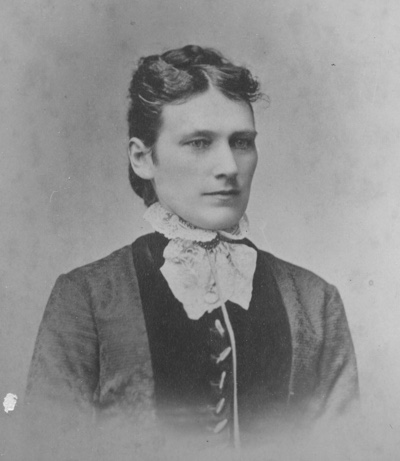
Ursula Gestefeld*
(1845-1921)
Ursula Gestefeld, along with Emma Curtis Hopkins, were once trusted lieutenants in Mary Baker Eddy’s Christian Science movement, but reacted against her authoritarian possessiveness and broke with her to became teachers of men and women who later founded movements of considerable extent and influence that have collectively been considered as New Thought groups.
Ursula Newell Gestefeld, a founder of the Illinois Woman’s Press Association, also established the Science of Being, a New Thought religious system that gained her national prominence.
Born April 22, 1845 in Augusta, Maine, to an invalid mother, Gestefeld was a sickly child, and friends thought she would never live to maturity, But she did, married, and bore four children. By 1878, she and her husband, Theodore Gestefeld, moved to Chicago where he served as a reporter for The Chicago Tribune and as city editor of The Statts-Zeitung, a leading German newspaper.
She was already middle-aged before she heard of Christian Science, when a friend loaned her a copy of Science and Health by Mary Baker Eddy. Something of a radical by nature and training, she was out of sympathy with the traditional religious thought of the day, but in Science and Health she saw, “despite its contradictions and inconsistencies,” “a truth that if applied to the problems of individual and social life would make all things new.” Applying its principles to her own case she had in a period of three months, without the help of any practitioner, achieved a state of health beyond any previously enjoyed.
Her success led her to become not only a believer, but also a leader in the movement. When Mrs. Eddy appeared in Chicago and offered class instruction, she became a member and was taught by Mrs. Eddy in her class of May, 1884, held in Chicago. Mrs. Eddy early recognized in her a person of outstanding ability and welcomed her as an exponent of the new faith. Mrs. Gestefeld was a very able individual, and she gave herself unreservedly to the practice and teaching of Christian Science. A very effective teacher, she soon won a substantial following and established herself as a metaphysician. She practiced, wrote and taught mental healing in Chicago.
In her zeal to communicate her faith to others she turned to writing. In 1888, Gestefeld published a book under the title, “Ursula N. Gestefeld’s Statement of Christian Science,” and although she gave full credit to Mrs. Eddy as its founder, she got into trouble. Christian Science had already been stated by Mrs. Eddy in Science and Health and her other writings, and apparently she felt that was sufficient. She denounced Mrs. Gestefeld in the Christian Science Journal and practically cut her off from her movement.
She reacted vigorously to Mrs. Eddy’s attack upon her and wrote a caustic pamphlet under the title Jesuitism in Christian Science. She was expelled from the association, but far from ending Mrs. Gesterfeld’s career as teacher and practitioner, this launched her on an independent career of healing and teaching. One of the most articulate of the early Eddy converts, she eventually became recognized as a leader in the metaphysical movement which came to be called New Thought.
A great deal of her work was done in Chicago where she established herself and regularly taught classes, maintained a center and a church, published books and wrote in magazines as a means of disseminating her ideas. To the system which she eventually evolved, she gave the name “Science of Being.” She formed a club, the Exodus Club, a non-sectarian group which had for its purpose the imparting and receiving of instruction in the Science of Being. Out of the Exodus Club seems to have grown the church to which Mrs. Gestefeld gave the name the Church of the New Thought. No member was required to make any profession of faith or to subscribe to anything which his reason rejected.
She trained women to become certified leaders, teachers, traveling proselytizers or pastors. In 1895, she contributed to The Woman’s Bible, which summarized the Science of Being principals. She published two novels, several tracts and started the Exodus, a monthly magazine for the New Thought movement, serving as writer, editor and publisher. She even formed an Exodus Club, charging dues of $25 per year. By 1902, she had at least 300 members, while more than 800 attended her weekly sermons.
Gestefeld is probably best known for her novel, The Woman Who Dares, a protest against the hypocrisy of marriage. The work portrayed a male-dominated society that used all means-legal, political, economic and religious-to enforce women’s sexual subservience to men.
By the turn of the century, Gestefeld had expanded her mental health theories to include material wealth. She was a frequent speaker in metaphysical movement congresses, served as member of the Executive Committee of the Metaphysical League, and was present at the formation of the International New Thought Alliance in London in 1914, and continued to write and lecture throughout the 1910s. She died of toxemia in 1921 and is buried at Graceland Cemetery, Chicago.
Her other books, widely used by New Thought groups, were: The Breath of Life: A Series of Self-treatments, Reincarnation or Immortality, The Builder and the Plan, A Chicago Bible Class, and the only title by her currently in print, How We Master Our Fate.
*Source of this biography is not known.












